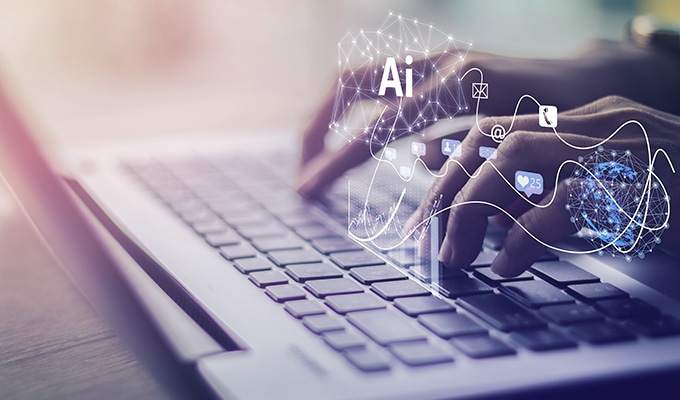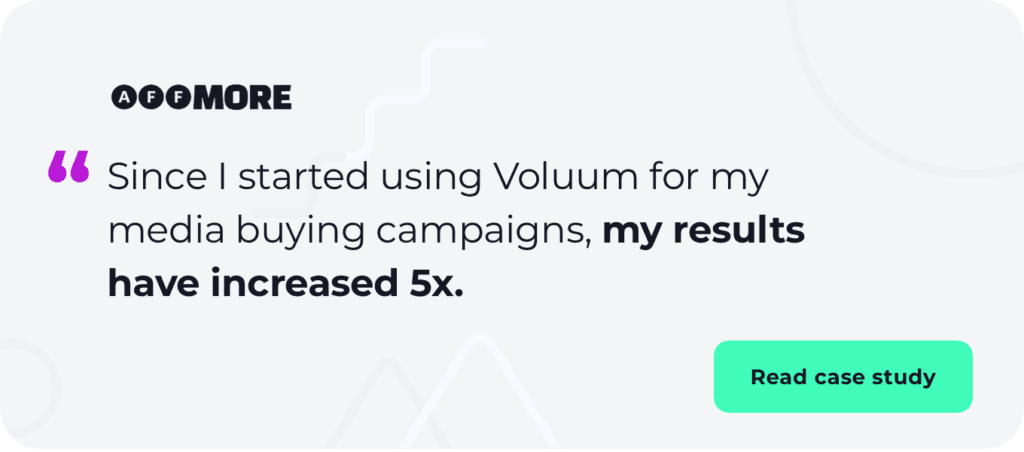This article about the future of advertising has been written by a bot.
[Insert a quote from William Gibson about an unevenly distributed future]
[Complain that it is hard to be a prophet in your own land]
[Provide some stats that the growth of digital ad spend will continue]
[Bring up a scene from Minority Report, where Tom Cruise sees personalized ads after his eyes get scanned]
Okay, okay, it’s not a bot that wrote this article, but a thirty-something content manager from an ad-tech company. The recent advances in AI, however, make content generation possiblewith some caveats. We will talk some more about this later.
Now it is a good moment to take a step back and think about how the whole digital advertising industry may look in the next ten years.
The Future is Going To Be Like Present But More Futuristic
We at Codewise try to guess or predict what the future of advertising holds. We know that there are known unknowns and unknown unknowns. Yet, taking into account all the variables and changes, we are confident that it is possible to talk about the future. Mainly because…
…the future of advertising has already started some time ago.
Most of the trends that will dominate digital advertising in the next decade have already kicked off. The tough point is to predict, which of these trends will have the greatest impact on the industry.

Where are we now?
The state of the digital advertising industry circa 2021 is: blooming, under scrutiny, hungry for a change.
The state of the users is: blind to traditional ads.
From this, several patterns emerge and start to shape the future of advertising.
Shapes of tomorrow
The main buzzword of today is storitization. What this clunky word means is that every ad experience will have a narrative, with its own pace and plot points attached to it.
Advertisers no longer want you to remember technical specs of their products, they want you to feel specific emotions when you think or interact with their product. This brings you closer to the brand
And what better way to make you feel strong emotions than by engaging in various social issues. This makes what is often referred to as ‘woke’ marketing.
It’s not about products anymore.
Watching these online ads, you learn nothing about the products. You feel everything when you recall these brands.
It’s not for everyone, you can easily overdo it if your brand’s sudden interest in social issues will feel dishonest. Ben&Jerry’s are honest because they were doing this for years. Consider if such an approach fits your strategy.
Individual marketing campaigns
Different storytelling methods often come in hand with another trend that we can observe: personalization.
No more ‘one-size-fits-all’ ad campaigns with big budgets that try to talk to everybody in the same way.
A time of smaller, personalized ads in campaigns with even bigger budgets is coming.
Users respond better to content that seems to be tailored just for them.
Only recently, the best advertisers could do was to display a message “Hello [smartphone_brand] user, buy a new protective cover”.
Now, we are approaching the world where each user gets a unique message: “Hello John Doe, in the light of your recent breakup, would you consider buying a new smartphone that will make you look cool again?”
This is something that will be possible by employing technology (artificial intelligence to be more specific), not people.
On the other hand, such precise content targeting may and will result in more privacy-protecting legislatives. Microtargeting may be seen as too intrusive. It is safe to say that there will be some boundaries to how granularly you can target people.
Personalization won’t be achieved without measurability. This is an old problem in a new disguise.
[Insert a quote from Peter Drucker about measuring things and managing them]
It’s not about clicks and conversions anymore. How about measuring an emotional response? Eye focus? Heart rate? The tech of tomorrow will gather all sorts of data. take Meta’s most recent invention: Oculus Quest Pro with eye-tracking. Sure, it supposedly is used for foveated rendering only but it would be unwise to assume that information about where you focus your eyes won’t be recorded and used for analytical purposes.
On the other hand, tracking every single individual is harder because of aforementioned privacy issues. Not to mention that it may not be economical.
From the point of view of a person running an ad campaign, a single visitor belongs to a group of other visitors, similar in terms of spending habits but not necessarily in others, like demography and location.
It may be more practical not to treat people as individuals and trying to custom tailor a message for everyone but rather as a part of a group – but not the one based on demographic characteristics.
Think about it. You may not be as unique as you would like to think. And AI can group people with surprising accuracy, better than any classic marketing theory would suggest.
Dimensions of change
These trends will require or make use of changes in the legal framework, technological advancements and payment flow. Let’s go over each of these dimensions.
The First Dimension: The Legal Framework
When it comes to future-thinking, everyone likes to talk about new gadgets and gizmos, cyberspace, AI and space ads.
Let’s kick-off with something less spectacular, but probably more profound:
GDPR.
Its introduction has changed a lot for advertisers, not only European ones. The annoying cookie-consent popups user experience aside, it made advertisers rethink how they approach the collected user data.
Before GDPR, the idea was to feed marketing experts or AI with as much data as possible and wait for them to come up with the best strategy.
After GDPR, this brute-force mechanic has found its limits and marketers have to be smarter in the way they use tracked data. The GDPR framework did not only gave an option to opt-out from data-collecting processes, which caused the volumes of data to drop but at the same time raised the quality of data. AI’s or marketing experts don’t have to search for patterns amidst the white noise.
The impact of GDPR on the industry has crossed the EU boundaries. At this moment, many countries outside the EU are revising their privacy policies. In the US, companies themselves are asking for GDPR-like regulations.
The GDPR legislation, along with various privacy scandals or data leaks, has also changed a lot for users by putting the privacy issue on the lips of common people. Some are annoyed by yet another popup. Others are distressed because of discovering how much data has been gathered on them by companies.
The newest legal change proposed by the EU are the DSA&DMA acts. They are a whole legal framework that, on the one hand, may severely limit what is allowed for advertisers but on the other hand, give advertisers plenty of new opportunities thanks to allowing alternative app stores on mobile devices.
The Future
The issues of privacy, data ownership and leveling the playfield have changed and will change the industry forever. Ten years ago, only geeks cared about where their data is stored and what this data is. Nowadays, a dating app becomes a matter of national security. A video sharing app is seen as a potential threat and is banned from government devices. There is no going back.
Rise of ad blockers
Ad blockers are a way for users to say that they have had enough. According to reports, 47% of Internet users have some sort of ad blocking mechanisms enabled. This increases the costs of advertising and the only way to combat that is to work towards more user-friendly ads for better customer experience.
New sources of user data
With more data, the only way is forward. These new sources include:
- Biometric data, from advanced smartphones and security systems that use fingerprints, facial recognition or retinal scans.
- Behavioral data, collected by wearables, eye-tracking cameras or similar devices, deduced from analyzing people’s walking patterns from city monitoring cameras.
- Voice samples, recorded by smart speakers, smart displays and all other voice-controlled devices.
Both law and technology can provide users with tools to control their data better. And people running ads will have to be more open, honest, and selective when gathering data. Location of servers, and to be more specific, the jurisdiction which they fall under, will also influence the future of advertising.
The AI-produced information
The big and still not fully unaddressed unknown are the outcomes produced by automatic, AI-powered systems. By looking for patterns in scraps of user data, automatic systems will be able to predict user behavior to a bigger extent than a user may have consented to. Both users and advertisers don’t know the full scope of information that can be derived from seemingly innocent user data.
The last point to make here is the opt-out option. It is still relatively easy to resign and withdraw one’s consent to data storage. But if one’s data is used to train AI, the deletion of the source data may not be enough. The results such AI delivers will be somehow influenced by data that a company has no longer rights to.
Everything that was mentioned above merely gives a glimpse into the challenges that lawmakers and, consequently, users and advertisers will have to face in the coming years. New regulations are inevitable.
Fake news or justified opinions
Social media owners feel a great pressure towards making their platforms immune to fake news. This is going to be a major challenge in the coming years and social media don’t won’t to be the ones that have to tell the truth from lies.
It’s not easy, given how good deepfake videos or other types of misinformation are.
Intel is already working on technology that can spot deepfakes
Advertising on social media will require going through several automatic or human-operated filters that will check if claims from the ad are even remotely valid.
The Second Dimension: The Technical Challenges And Opportunities
Now it’s time for the future to hit us with the coolest devices it has: VR/AR glasses, smart assistants, gadgets you previously didn’t know existed but now desperately crave for… wait, no? Won’t that be the biggest change happening in the next decade?
This new tech will obviously give people running ads new channels to reach potential consumers, but probably the most important tech innovations will be less spectacular.
Connecting the dots
Even now when we speak of marketing channels, we think of separate campaigns. We use similar creatives and content, but ‘email advertising’ and ‘mobile advertising’ channels aren’t directly connected. But it’s not how real people use the Internet.
They have various devices. They start reading a web page on a laptop and finish it on a mobile device. They cast media on their TVs and ask their smart displays questions. The shopping list is written on a smart fridge and brought up on a smartwatch when they enter a store.

There are many possible touchpoints, i.e. interactions with a product, in the modern world. To build a meaningful connection with a user, you have to be visible in many channels and, what is even more important, track users’ journeys across multiple platforms and devices.
The cost model of tomorrow is not click-centric, but consumer-centric.
The future advertising platforms will allow you to map the entire history of consumers’ interactions, get data on all the touchpoints and adjust your messaging accordingly.
So the biggest technical advancement will allow to offer a consistent and unifying marketing experience to consumers.
New marketing channels and 5G
Joining various points becomes an even more pressing matter when you take into account all the new ways of how users will be able to interact with your brand.
- Imagine presenting your product in a virtual or augmented reality.
- Imagine smart assistants proactively promoting your offers.
- Imagine your ads shown on TVs, fridges or microwave ovens’ displays.
In ten years, IoT or smart devices will simply become just devices. Their online capabilities will be so obvious that no one will even bother to mention them.
The adoption of 5G technology will allow you to present your ads in a much higher quality. Think 8K or 360 video ads, 3D models, 100 MP images and so on.
Taking advantage of this will require new creative approaches and a complete rethink of how a typical marketing campaign is structured. Omnichannel marketing will take over traditional ‘email’ or ‘social’ marketing campaigns.
Shopping is everywhere
The big focus right now is on reducing the hardship of making an online purchase. Yes, it’s too difficult right now, at least that’s what the companies are thinking. Shoppable posts are not all, visual search, as introduced by Snapchat and Amazon, allows you to buy products that you see instantly.
Not enough? Ikea had employed augmented reality to allow you to do the exact opposite: buy stuff that you don’t have but wonder how they would look like. For example, you can use your smartphone to check out how a new coffee table would present itself in your living room and purchase it immediately once you decide that it really ties the room together.
The oligopoly of big players
The future of digital ads may have its price. We already see a couple of big players, namely Google and Facebook, dominating the ad industry. Let’s look into some other potential big players that may join the advertising game:
- Supperapps developers. A superapp is a mobile application that is almost like a mini operating system and allows its users to perform most of the daily online tasks within one environment.
Invented in ‘mobile-first’ Asian countries, these apps may become ‘the Internet’ for many users. The most prominent example is WeChat. In the west, Twitter is aiming at becoming a superapp.
Think of them as Uber, Amazon, and Airbnb combined. Having these kinds of services inside one app will make users spend most of their online time there. And whoever operates ads in these superapps, controls marketing in entire populations.
- Smart TVs manufacturers. For now, TVs display ads mainly in the context of apps that are installed on them. But soon, TV manufacturers may decide to cut out the middlemen and display ads by themselves.
The experience we know from ad-enabled Kindles is now coming to the millions of huge displays hanging in the prominent spots in living rooms all around the world.
The same reasoning may be adopted by smartphone manufacturers. Such a company, Samsung for example, would instantly become a heavyweight champion in the industry if only they chose to introduce ads on their mobile devices.
The removal of ad agencies from the marketing chain is already happening. For example, Instagram has released a feature that allows brands to connect with influencers directly.
Balkanization of the Internet or the birth of the splinternet
The time when the Internet was a global anarchic platform without nationality has come to an end in recent years. Big techs have changed it into oligopoly.
Now we learn that big tech players also have nationality and an agenda. Chinese and Western nets are divided more and more. Soon an advertiser may not be able to run global campaigns and switch from country to country with ease.
There have always been barriers between countries in the online world – one just has to look into the Netflix library in various countries to notice that. But the new, divided Internet – splinternet – may consist of completely incompatible parts.
Bots writing content
Although human creativity seems to have no limits, it definitely has its pace. Advertisers won’t be able to produce enough content by hiring content writers only.
All these personalized messages, custom-tailored VR ads and so on cannot be created solely by people. The marketing departments would have to hire half of the world’s population to design ads for the other half.
A lot of tasks that are connected with launching a campaign will be automated. Writing a simple text ad will not require a content writer.
[Insert sad face emoji and play sad violin in the background]
Even video advertising may be overtaken by artificial intelligence, with deepfake technology being able to produce almost any video on demand.
However, more creativity will be required on a grander level, when designing a campaign that incorporates all the new tech and new trends. AI will most likely be used to back the efforts of content writers. The best example of such an approach are paraphrasing tools, which can create variants of the same landing page with similar yet unique content.
Similarly, AI image generators are not precise enough, and perhaps never will be precise enough to create new company logos or design creatives for an ad campaign. They could, however, help designers to create illustrative in-text images for purely decorative purposes.

What remains of traditional advertising
The remaining changes that I can mention are the rise of voice searches and searches in natural language, digital out-of-home (DOOH) advertising, advertising in over-the-top media services, and blockchain.
The use of blockchain technology will probably have the greatest impact on the economic level that will be discussed in the next segment.
The Third Dimension: Money Talks
The average price of a click varies across verticals, but it is climbing up. Briefly speaking, the competition is bigger and the increase of an ad space does not cover the demand. On top of that, ad blocks usage is still going up and bot traffic, despite the small drop, still makes the huge chunk of traffic.
People running ads have to re-envision their monetization strategies and how their advertising dollars are spent.
For starters, the lifetime value of a customer will be more important than the cost of a click.
With the holistic approach to a user’s history of touchpoints throughout various channels, focusing on the cost of a click will prove to be inefficient in the long run. What will count more and what advertisers will finally be able to track is the value generated by a user over time.
Blockchain rescues the advertising industry
Blockchain technology can change a lot in the advertising industry:
- A universally trusted ledger of transactions can help fight ad fraud and eliminate the middlemen.
- The ability to record each step of a transaction inside one incorruptible database will make the industry more transparent.
- Easy identity verification can help track users across the web.
- Different monetization methods for advertisers may come from rewarding users that engage with ads with microtransactions.
All of this may have a profound impact on how the industry operates. Blockchain technology can significantly reduce costs but it may speed up the division of the advertising market between big players even further by removing intermediary parties.
Digital commodities
Blockchains have recently brought to the table a new way of allocating capital. I’m not (only) talking about Bitcoin and other cryptocurrencies (read the article about the crypto vertical) but also NFTs.
NFTs, or nonfungible tokens, are unique digital identifiers of either physical or digital products. While the NFT market if far from its former glory, the truth is that there’s simply a lot of money circling the world (partially because of generous government donations caused by the pandemic) in need to be invested, and digital commodities, be that NFT’s or something else, are a good fit.
Digital commodities will not only be lifestyle items, such as ebooks or Netflix subscriptions but also a serios way to put significant money in. This new breed of products will require new advertising.
The spending paradox
Advertising agencies that will or will not adopt the blockchain technology may still be eliminated from the market by the known paradox:
The more successful they are, the more their customers spend on advertising. The more they spend, the bigger temptation they may feel to move all media buying operations in-house.
Truth be told, all these fancy AI-powered trackers and affiliate tracking software will require significant investments. The future of advertising most likely belongs to the biggest and/or the smartest, at least on more developed markets.
New markets and new prospects
With the hardened Internet users in more developed countries being more and more immune to advertising tricks, the focus of smaller players may shift towards new markets.
As of now, more than half of the world’s population is connected to the Internet. This means that there are 3 billion people that are yet to see the Internet for the first time. Various technological advancements and initiatives already try to make the Internet more accessible.
Imagine the change that 3 billion fresh customers entering the market will make.
Elon Musk’s Starlink has already connected 10,000 users to the Internet and this is just one, probably the most futuristic, but still one technology that will bring new people online.
The war and economic crisis
The ad industry is a boat that floats up and down according to economic tides. When the overall situation gets worse, companies will cut their ad budgets first. BUT, they won’t limit the ad spend if those ad dollars generate actual revenue. If it can be proven, and in the digital world it can with proper tracking, no CMO in their right mind would do so.
Measurements are everything, in crisis or during economic boom.
Future of AI in advertising
Although we already talked about AI in advertising a bit, circling back to this topic makes sense, since it is an all-encompassing technology. It affects all dimensions: legal, technological and financial. No matter what your stance on the quality of content produced by generative AI is, you can’t deny the revolutionary potential of this technology.
Probably the most influential aspect of GAI is lowering the cost of producing content. This in turn enables faster A/B testing and – as a result – more custom-tailored campaigns that engage more.
The benefits are clear: advertisers are able to convey their messages more efficiently, the users will get better content, product owners will have more customers. In this view, GAI is a tool, not a replacement. It is what an electronic calculator was to an accountant.
Google’ approach to AI-produced content is rational: as long as content provides value to end users, Google won’t care how it was produced. What will Google fight with is AI content produced solely for the purpose inf inflating numbers and thus manipulating SERP ranking. But if you are not doing that, you can use general-purpose AIs such as ChatGPT or solutions tailored toward marketing needs such as Jasper.AI.
The future of programmatic buying
The next place where AI starts to shine as well is programmatic buying. Until now, DSPs and SSPs were using rather simple algorithms for managing media buying. AI and machine learning can turn such often-inefficient decision-making processes into areal advantage.
Programmatic ad buying of the future will only purchase traffic most relevant to a marketer. This will make the general cost of advertising go further down, enabling new actors to enter the market. Even smaller brands will have a chance os presenting themselves in front of precisely outlined audiences. AI programmatic media buying will empower marketers even more.
It is hard to predict the future of advertising and even harder if you want to get it right
The following article is a shallow swim rather than a deep dive into everything the future of advertising may hold. Yet, I’ve tried to point out the trends that we can currently observe and that will most likely influence the future the most, as well as areas of change.
The beginning of a new year is always a good time to think about the future. I’ve provided you with material and you have to do the thinking.
[Insert a pun that ties a nice bow on the article]
Wherever you will be in the advertising industry in ten years, remember this article and tell me, how well it aged.






4 comments
Thank you very much for sharing.
Very good topic. Thanks for sharing.
useful information on topics that plenty are interested on for this wonderful post.
Great article. Couldn’t write much better! Keep it up!